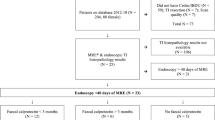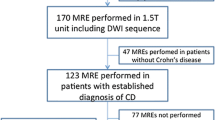Abstract
Objective
To compare quantified terminal ileal (TI) motility during MR enterography (MRE) with histopathological severity of acute inflammation in Crohn’s disease.
Methods
A total of 28 Crohn’s patients underwent MRE and endoscopic TI biopsy. Axial and coronal TrueFISP, HASTE and post-gadolinium VIBE images were supplemented by multiple coronal TrueFISP cine motility sequences through the small bowel volume. TI motility index (MI) was quantified using validated software; an acute inflammation score (eAIS; 0–6) was assigned to the biopsy. Two observers qualitatively scored mural thickness, T2 signal, contrast enhancement and perimural oedema (0–3) to produce an activity score (aMRIs) based on anatomical MRI. The association among the MI, eAIS and aMRIs was tested using Spearman’s rank correlation. Wilcoxon rank sum test compared motility in subjects with and without histopathological inflammation.
Results
Mean MI and mean eAIS were 0.27 (range 0.06–0.55) and 1.5 (range 0–5), respectively. There was a significant difference in MI between non-inflamed (mean 0.37, range 0.13–0.55) and inflamed (mean 0.19, range 0.06–0.44) TI, P = 0.002, and a significant negative correlation between MI and both eAIS (Rho = −0.52, P = 0.005) and aMRIs (R = −0.7, P < 0.001).
Conclusion
Quantified TI motility negatively correlates with histopathological measures of disease activity and existing anatomical MRI activity biomarkers.
Key Points
• Magnetic resonance imaging is increasingly used to assess Crohn’s disease.
• MRI measurements can provide a quantitative assessment of small bowel motility.
• MR enterography can grade Crohn’s disease.
• Small bowel motility can be used as a marker of inflammatory activity.




Similar content being viewed by others
References
Colombel JF, Solem CA, Sandborn WJ et al (2006) Quantitative measurement and visual assessment of ileal Crohn’s disease activity by computed tomography enterography: correlation with endoscopic severity and C reactive protein. Gut 55:1561–1567
Minordi LM, Vecchioli A, Guidi L, Poloni G, Fedeli G, Bonomo L (2009) CT findings and clinical activity in Crohn’s disease. Clin Imaging 33:123–129
Chiorean MV, Sandrasegaran K, Saxena R, Maglinte DD, Nakeeb A, Johnson CS (2007) Correlation of CT enteroclysis with surgical pathology in Crohn’s disease. Am J Gastroenterol 102:2541–2550
Sjekavica I, Barbaric-Babic V, Krznaric Z, Molnar M, Cukovic-Cavka S, Stern-Padovan R (2007) Assessment of Crohn’s disease activity by Doppler ultrasound of superior mesenteric artery and mural arteries in thickened bowel wall: cross-sectional study. Croat Med J 48:822–830
Haber HP, Busch A, Ziebach R, Stern M (2000) Bowel wall thickness measured by ultrasound as a marker of Crohn’s disease activity in children. Lancet 355:1239–1240
Girlich C, Schacherer D, Jung EM, Schreyer A, Buttner R (2011) Comparison between a clinical activity index (Harvey-Bradshaw-Index), laboratory inflammation markers and quantitative assessment of bowel wall vascularization by contrast-enhanced ultrasound in Crohn’s disease. Eur J Radiol. doi:10.1016/j.ejrad.2011.02.054
Horsthuis K, Bipat S, Bennink RJ, Stoker J (2008) Inflammatory bowel disease diagnosed with US, MR, scintigraphy, and CT: meta-analysis of prospective studies. Radiology 247:64–79
Taylor SA, Punwani S, Rodriguez-Justo M et al (2009) Mural Crohn disease: correlation of dynamic contrast-enhanced MR imaging findings with angiogenesis and inflammation at histologic examination–pilot study. Radiology 251:369–379
Punwani S, Rodriguez-Justo M, Bainbridge A et al (2009) Mural inflammation in Crohn disease: location-matched histologic validation of MR imaging features. Radiology 252:712–720
Horsthuis K, Bipat S, Stokkers PC, Stoker J (2009) Magnetic resonance imaging for evaluation of disease activity in Crohn’s disease: a systematic review. Eur Radiol 19:1450–1460. doi:10.1007/s00330-008-1287-0
Rimola J, Ordas I, Rodriguez S et al (2011) Magnetic resonance imaging for evaluation of Crohn’s disease: validation of parameters of severity and quantitative index of activity. Inflamm Bowel Dis 17:1759–68
Steward MJ, Punwani S, Proctor I et al (2011) Non-perforating small bowel Crohn’s disease assessed by MRI enterography: derivation and histopathological validation of an MR-based activity index. Eur J Radiol. doi:10.1016/j.ejrad.2011.07.013
Froehlich JM, Waldherr C, Stoupis C, Erturk SM, Patak MA (2010) MR motility imaging in Crohn’s disease improves lesion detection compared with standard MR imaging. Eur Radiol 20:1945–1951
Girometti R, Zuiani C, Toso F et al (2008) MRI scoring system including dynamic motility evaluation in assessing the activity of Crohn’s disease of the terminal ileum. Acad Radiol 15:153–164
Wakamiya M, Furukawa A, Kanasaki S, Murata K (2011) Assessment of small bowel motility function with cine-MRI using balanced steady-state free precession sequence. J Magn Reson Imaging 33:1235–1240
Webb AG, Ailiani AC, Neuberger T et al (2009) Quantitative analysis of peristaltic and segmental motion in vivo in the rat small intestine using dynamic MRI. Magn Reson Med 62:116–126
Odille F, Menys A, Ahmed A, Punwani S, Taylor SA, Atkinson D (2012) Quantitative assessment of small bowel motility by nonrigid registration of dynamic MR images. Magn Reson Med. doi:10.1002/mrm.23298
Patak MCJ, Szusc-Farkas Z, Patuto N, Tutuian R, Riable S, Froehlich J (2011) MR motility measurement for the evaluation of Crohn’s disease activity compared to biopsy. ESGAR proceed ings. Insights into Imaging 2(supp 2)403–451: S440. doi:10.1007/s13244-011-0095-2
Menys AAA, Odille F, Punwani S, Atkinson D, Taylor S (2011) Quantified small bowel motility during MR enterography in Crohn’s disease as a marker of inflammatory activity. ESGAR proceedings. Insights Into Imaging 403–451 2(supp 2):S439. doi:10.1007/s13244-011-0095-2
Stange EF, Travis SP, Vermeire S et al (2006) European evidence based consensus on the diagnosis and management of Crohn’s disease: definitions and diagnosis. Gut 55(Suppl 1):i1–i15
Poole DP, Matsuyama H, Nguyen TV, Eriksson EM, Fowler CJ, Furness JB (2007) Inflammation and inflammatory agents activate protein kinase C epsilon translocation and excite guinea-pig submucosal neurons. Gastroenterology 133:1229–1239
Krauter EM, Linden DR, Sharkey KA, Mawe GM (2007) Synaptic plasticity in myenteric neurons of the guinea-pig distal colon: presynaptic mechanisms of inflammation-induced synaptic facilitation. J Physiol 581:787–800
Bauer AJ (2008) Mentation on the immunological modulation of gastrointestinal motility. Neurogastroenterol Motil 20:81–90
Brown SR, Cann PA, Read NW (1990) Effect of coffee on distal colon function. Gut 31:450–453
Hogan AM, Kennelly R, Collins D, Baird AW, Winter DC (2009) Oestrogen inhibits human colonic motility by a non-genomic cell membrane receptor-dependent mechanism. Br J Surg 96:817–822
Froehlich JM, Daenzer M, von Weymarn C, Erturk SM, Zollikofer CL, Patak MA (2009) Aperistaltic effect of hyoscine N-butylbromide versus glucagon on the small bowel assessed by magnetic resonance imaging. Eur Radiol 19:1387–1393
Acknowledgement
This work was undertaken at the Comprehensive Biomedical Centre, University College Hospital London, which received a proportion of the funding from the National Institute for Health Research. The views expressed in this publication are those of the authors and not necessarily those of the UK Department of Health. Grant funding from the pathological Society of Great Britain & Ireland.
Author information
Authors and Affiliations
Corresponding author
Rights and permissions
About this article
Cite this article
Menys, A., Atkinson, D., Odille, F. et al. Quantified terminal ileal motility during MR enterography as a potential biomarker of Crohn’s disease activity: a preliminary study. Eur Radiol 22, 2494–2501 (2012). https://doi.org/10.1007/s00330-012-2514-2
Received:
Revised:
Accepted:
Published:
Issue Date:
DOI: https://doi.org/10.1007/s00330-012-2514-2




